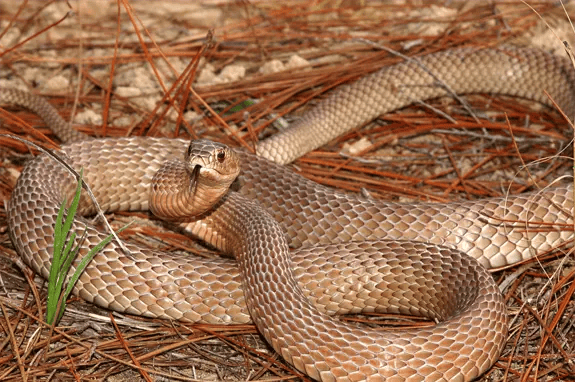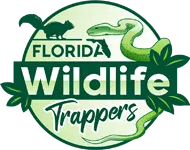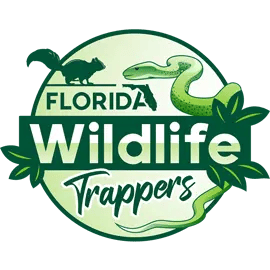Eastern Coachwhip
- Scientific Name
- Masticophis flagellum ssp. flagellum
- Also Known As
- Eastern Coachwhip
- Range
- All of Florida
- Diet
- Small Mammals, Birds, Lizards, Snakes
- Life Expectancy
- 6 - 8 Years
Quick Links
Eastern Coachwhip Snakes in Central Florida
The eastern coachwhip (Masticophis flagellum ssp. flagellum) is a large, nonvenomous colubrid species found throughout Florida. Often confused with similar-looking ratsnakes and racers, the coachwhip can be identified by its elongated body, distinctive color pattern, and rapid defensive movements.
This comprehensive guide provides detailed identification tips, biology facts, and information on prevention and control methods for eastern coachwhips in central Florida. Read on to learn about coachwhip habits, reproduction, diet, health risks, signs of an encounter, and professional removal options if you spot one on your property.
Appearance and Identification
Eastern coachwhips can be distinguished from other snakes by their elongated shape, smooth dorsal scales, coloring, and defensive posture
When threatened, coachwhips flatten their head and vibrate their tail rapidly, which produces a loud rattling sound against dry vegetation. This along with their speed often deters predators
Maturation Rate
Young coachwhips grow rapidly after hatching. They shed their skin frequently as juveniles to accommodate fast growth. Within their first year, coachwhips can reach over 3 feet (around 1 meter) long before slowing their growth rate. They gain an additional 1 to 3 feet per year until reaching adult size by age 2 to 3.
Habits and Behavior
Eastern coachwhips are active during the day, especially in warmer weather. They prefer open habitat like pine flatwoods, scrub, grasslands, and sandy areas near coastlines. Coachwhips are fast-moving snakes, capable of reaching speeds over 7 mph for short bursts. This allows them to actively pursue lizard and rodent prey.
Coachwhips are oviparous, meaning they lay eggs rather than giving live birth. Females stay near their eggs until they hatch, defending them from potential predators. When encountered, coachwhips will often try to flee. But if threatened, they may flatten their head into an S-shape, vibrate their tail, strike, release musk and feces, or enact other defensive maneuvers.
Reproduction and Lifespan
Eastern coachwhips mate from April to June. Females lay clutches of 4 to 23 eggs in June and July in sunny, sandy areas. The eggs incubate for 50 to 65 days before hatching from July through September. Hatchlings are independent immediately.
Coachwhips reach reproductive maturity within 2 to 3 years. Their typical lifespan in the wild is 6 to 8 years. The record longevity is over 12 years.
Ideal Habitat and Range
Central Florida’s hot, humid climate with sandy pine and oak scrub forests offers prime habitat for eastern coachwhips. Average temperatures range from the 60s°F in winter to over 90°F in summer. Annual rainfall totals 52 inches on average.
Coastal grasslands, inland xeric pinelands, sandy ridges, and citrus groves provide ideal coachwhip habitat. Plentiful lizard and rodent prey thrives across the region. Rural housing near scrub and open woods also attracts coachwhips searching for prey around homes.
The high availability of food, shelter, mates, and egg-laying sites allows coachwhip populations to prosper in central Florida. Management of overgrown brush and limiting access to human structures can discourage coachwhips from frequenting yards and developed areas.
Diet and Feeding
Eastern coachwhips prey predominantly on small mammals, birds, lizards, snakes, and amphibians. Using chemosensory cues to hunt, they pursue prey actively during the day. Their diet includes:
- Small rodents – mice, rats, voles, squirrels
- Lizards – skinks, anoles, whiptails
- Snakes – eggs, juveniles, and smaller species
- Frogs, toads, salamanders
- Nestling birds, eggs
- Large insects – grasshoppers, beetles
Coachwhips use constriction to subdue prey before swallowing it whole head-first. They can go weeks between meals. Coachwhips sometimes raid rodent dens and consume eggs and juveniles, providing pest control services. They may also opportunistically eat carrion.

Photo 176178923 © Ben, CC BY-ND

Common Health Risks
Eastern coachwhips are nonvenomous and not aggressive toward humans. They can deliver a painful defensive bite if severely threatened but rarely bite unless handled. Minor wounds from a bite may become infected without care.
Some key points:
- Coachwhip saliva is not toxic or medically significant.
- The teeth are small and bites generally do not cause major injury. Disinfect thoroughly as with any animal bite.
- Coachwhips are not carriers of any infectious diseases transmittable to humans or domestic animals.
- They help control rodent and insect pest populations and are generally beneficial to suburban environments.
- Coachwhips should not be harmed or killed as they are protected native wildlife species in Florida.
Preventing Eastern Coachwhip Encounters
To discourage coachwhips, keep yards free of heavy vegetation and brush piles. Closing openings in foundations, vents, and garages prevents access. Glue traps along building perimeters safely catch small snakes.
Remove outdoor food sources like pet bowls and fallen fruit to avoid attracting prey. Coachwhip-proof fencing provides a physical barrier to keep snakes out of gardens and play areas. Teach children to recognize coachwhips and not approach them.
Many coachwhip encounters are benign. If one is spotted on your property, allow it to move away undisturbed. Never attempt to kill or capture a coachwhip yourself – always call a professional wildlife removal expert for humane removal assistance.
Eastern Coachwhips in Central Florida – Conclusion
Eastern coachwhips are quick, common snakes that frequent open habitats in central Florida. They are an important part of the local ecosystem and avoid interactions with humans. With proper identification, exclusion techniques, and removal of habitat attractants, coachwhips can be deterred from taking up residence near homes.
Educational outreach also promotes tolerance and sensible precautions around these harmless native snakes.







